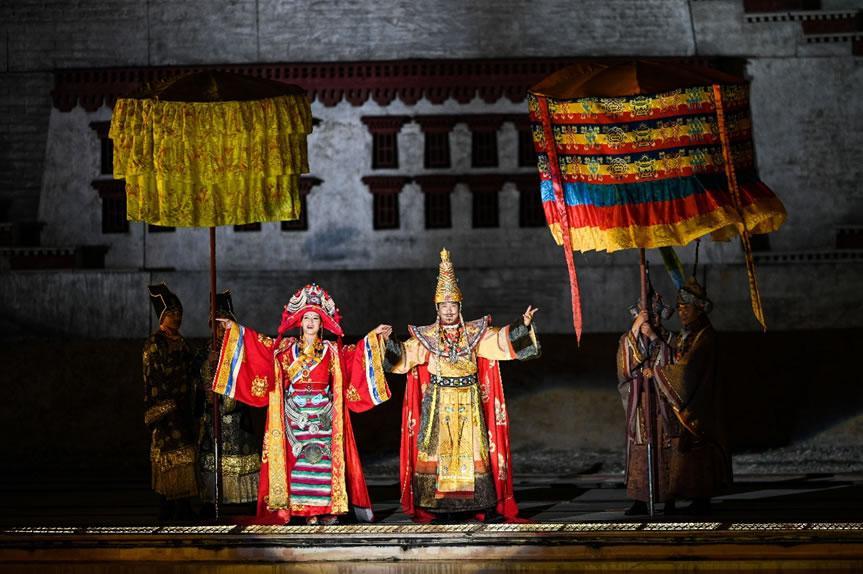What did the two Tang princesses contribute to Xizang?

Heqin in ancient China means intermarriages between the Central Plains dynasties and the border kingdoms, or among the border kingdoms themselves. This kind of marriage aims at coordinating ethnic relations and dealing with ethnic issues.
As it played a role that cannot be replaced by radical means such as war and suppression, heqin had always been favored by rulers in ancient China.
In Chinese history, Princess Wencheng and Princess Jincheng in the Tang Dynasty (618-907) are frequently mentioned with great admiration when it comes to heqin. Both of them were married to Tubo kings in Xizang.
In 641, the fifteenth year of the Zhenguan era, the Tubo Kingdom sent Gar Tongtsan as an envoy to Chang'an (today's Xi'an in Shannxi Province) and to escort Princess Wencheng to marry the Tubo king in Xizang. Songtsen Gampo, the Tubo king, led his officials and troops to Baihai near Heyuan (Maduo County in Qinghai Province) to greet the princess in person. This was the first marriage alliance between Tang and Tubo. In the decade from their wedding to the death of Songtsen Gampo, there were nothing but harmonious relations between Tang and Tubo. This was a period almost free from wars.
In the year 710 AD, Princess Jincheng married Tride Tsugtsen, the 36th ruler of the Tubo Kingdom. She lived in Tubo for 29 years and dedicated her entire life to promoting friendly relations between Tang and Tubo.
What did two Tang princesses bring to Xizang?
Princess Wencheng lived in Tubo for 40 years during which she did many good deeds for the local people and also promoted the development of the local society.
According to the Ladakh Chronicles, the Tubo people "produced cheese by curdling milk, extracted butter and whey from the cheese, made cheesecakes (also known as milk cakes) from the whey, made pottery with clay, erected water mills for grinding grains, and wove fabrics on looms," all of which were introduced by Princess Wencheng. Additionally, Princess Wencheng also contributed to the development of local wine-making techniques.
Princess Wencheng brought various items when she went to Tubo, including a statue of Shakyamuni Buddha, books on divination and arithmetic, medicine, craftsman skills, and various grain seeds. These materials and cultural achievements allowed Tubo to have extensive and concentrated exposure to the culture of the Central Plains.
On the other hand, when Princess Jincheng went to Tubo, she was accompanied by many craftsmen who brought with them advanced skills and techniques. This played an important role in the development of Tubo's crafts and music.
She also requested Confucian classics such as The Book of Rites and Spring and Autumn Annals from the government of the Tang Dynasty, indicating that Confucianism had already exerted a certain influence on the upper class of Tubo.
As Trisong Detsen and his son were both devoted followers of Buddhism, Princess Jincheng actively encouraged the entry of Han Buddhist monks into Xizang and facilitated Tubo envoys travelling to the Tang Dynasty to study Buddhism.
At that time, a significant number of Tubo people came to the Central Plains to study medicine and translated numerous medical books into Tibetan. Additionally, many Han people who served in the Tubo Kingdom during this period played important roles in fostering cultural exchanges between the Tang Dynasty and Tubo.
Moreover, in the early years of the Tubo Kingdom, marriage by robbing had been prevalent practices; but later on, it became customary among the people in Xizang to follow the tradition of "marriage arranged by parents and matchmakers," which was said to be promoted by Princess Jincheng.
Political marriages hereby paved the way for cultural exchanges between the Tang Dynasty and Tubo, transforming sporadic and informal exchanges into official, formal, and frequent interactions.
For example, under the influence of Princess Wencheng, Songtsen Gampo implemented a strategy of dispatching envoys to Chang'an and inviting Han Chinese specialists in to promote cultural exchanges between the Tang and Tubo.
Many Tubo youths attended imperial schools of the Tang to study law, arithmetic, and other subjects. After completing their education, some of them stayed and were appointed as officials serving the Tang government, while those who returned to Tubo became important ministers responsible for maintaining and developing cultural exchanges between the Tang and Tubo Kingdom.
Princesses' journey: passed down to the present day
To this day, the story of Princess Wencheng's journey to Xizang remains a popular theme in local folktales, poems, dramas, murals, and sculptures. It can be exemplified by the story of "The seven challenges to the bridegroom's envoy," which tells about the seven challenges that Emperor Taizong posed to Gar Tongtsan when the latter was in Chang'an as Tubo's envoy to escort Princess Wencheng on the way to Xizang to marry Songtsen Gampo.
There is a folk song titled Aima Yangjisong, which vividly depicts the joy of the local people upon Princess Wencheng's arrival in Tubo. The traditional Tibetan drama Songtsen Gampo narrates the entire process from Gar Tongtsan's arrival in Chang'an to submit marriage proposal to the meeting of Princess Wencheng with Songtsen Gampo in Lhasa.
In addition, the snow-capped plateau is home to many relics related to Princess Wencheng, such as the Temple of Princess Wencheng in Yushu Tibetan Autonomous Prefecture of Qinghai Province, statues and murals depicting Princess Wencheng and Songtsen Gampo at places like the Potala Palace and some temples in Shannan, Xizang. These works of art express people's high praise and admiration for the Tang princess who came from afar.
The author is Huang Weizhong, professor at the School of Chinese Classics, Renmin University of China.
Liu Xian /Editor Zhang Rong /Translator
Yang Xinhua /Chief Editor Ren Qiang /Coordinator
Liu Li /Reviewer
Zhang Weiwei /Copyeditor Tan Yujie /Image Editor
The views don't necessarily reflect those of DeepChina.
